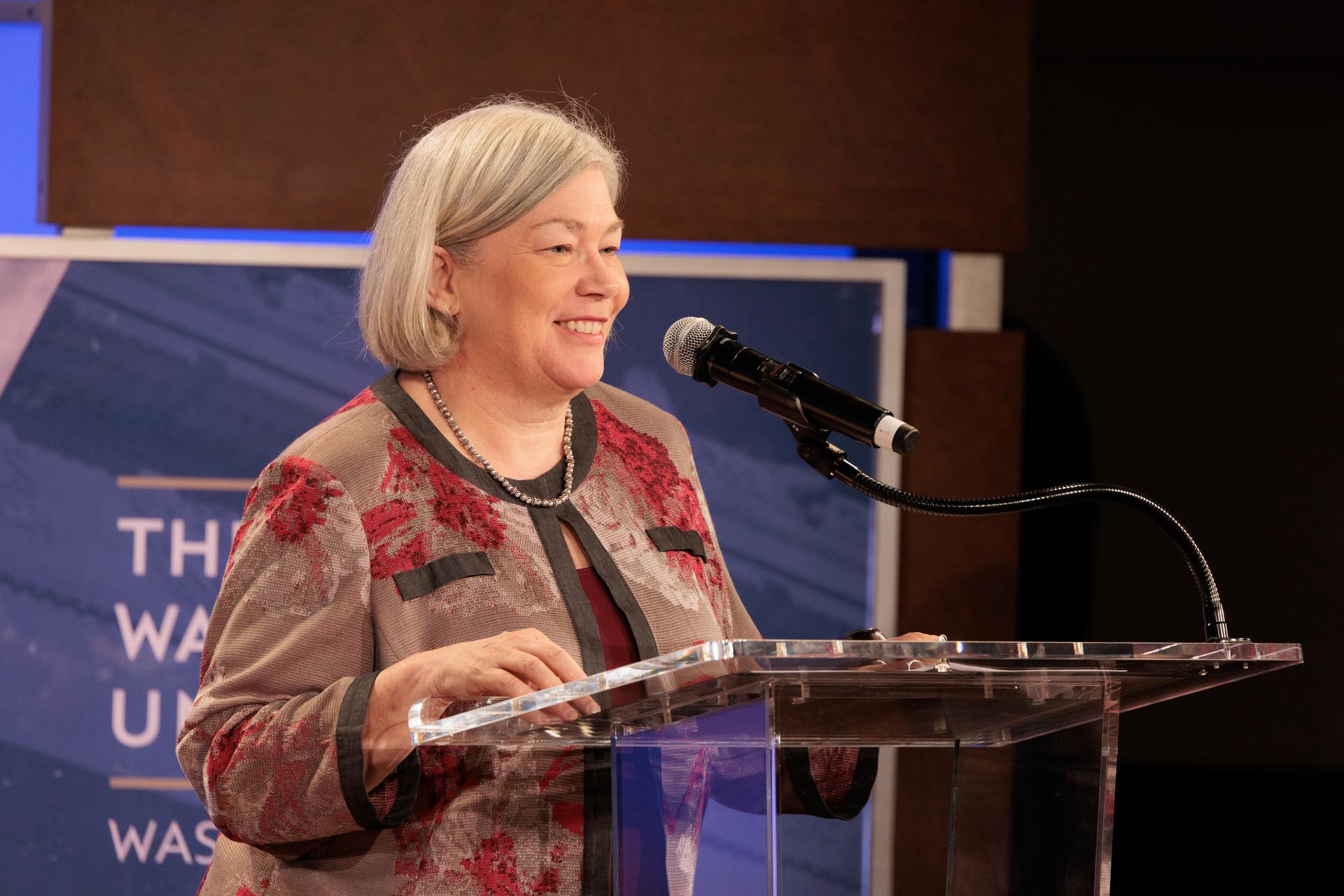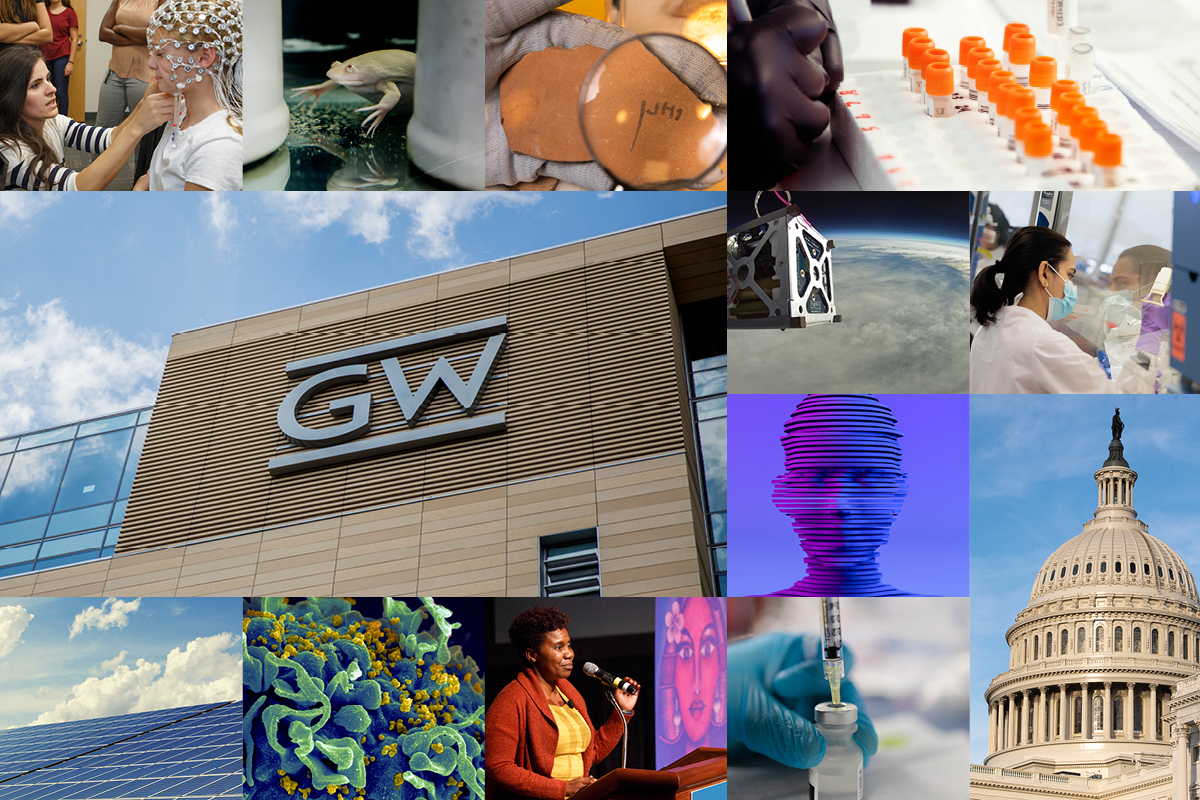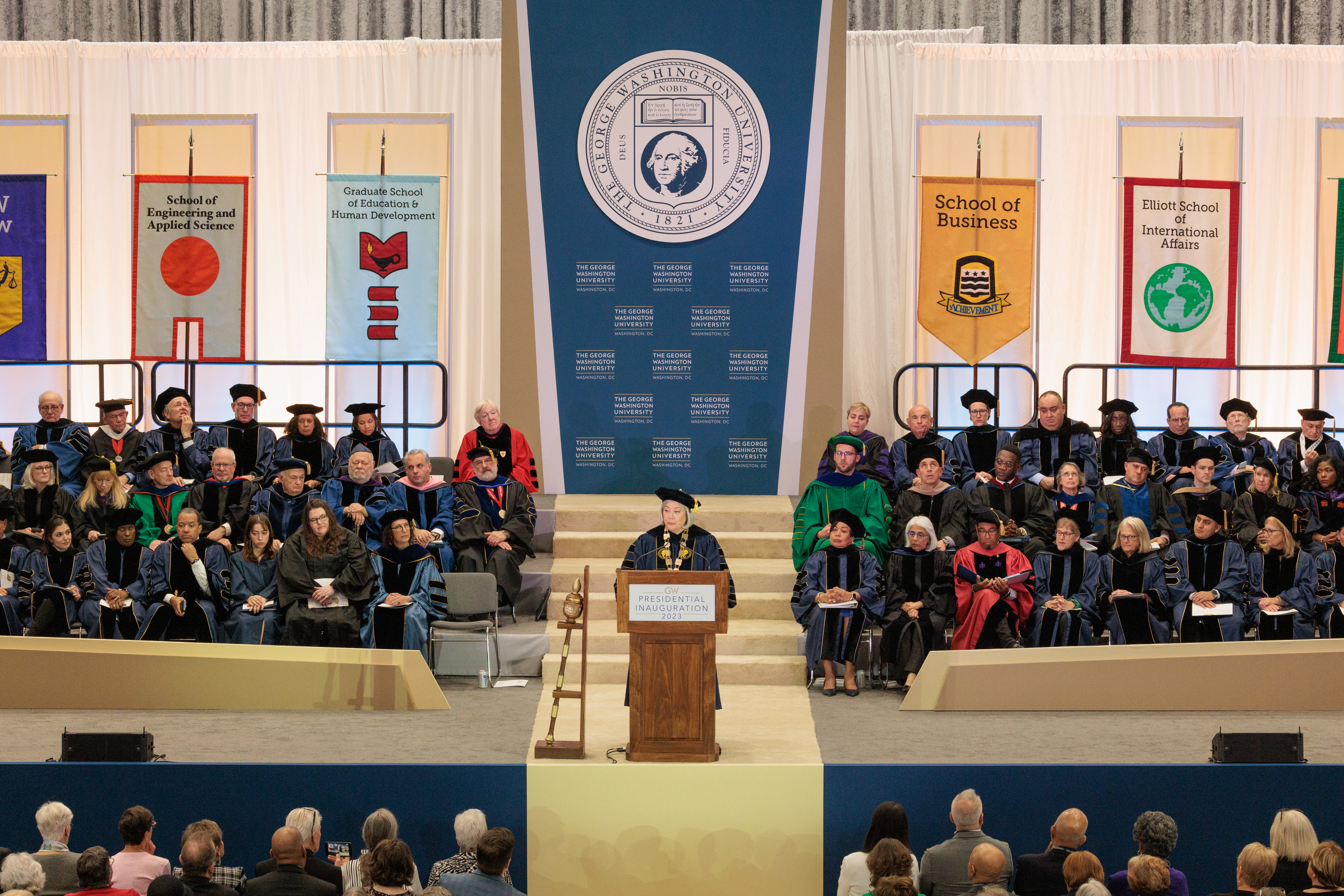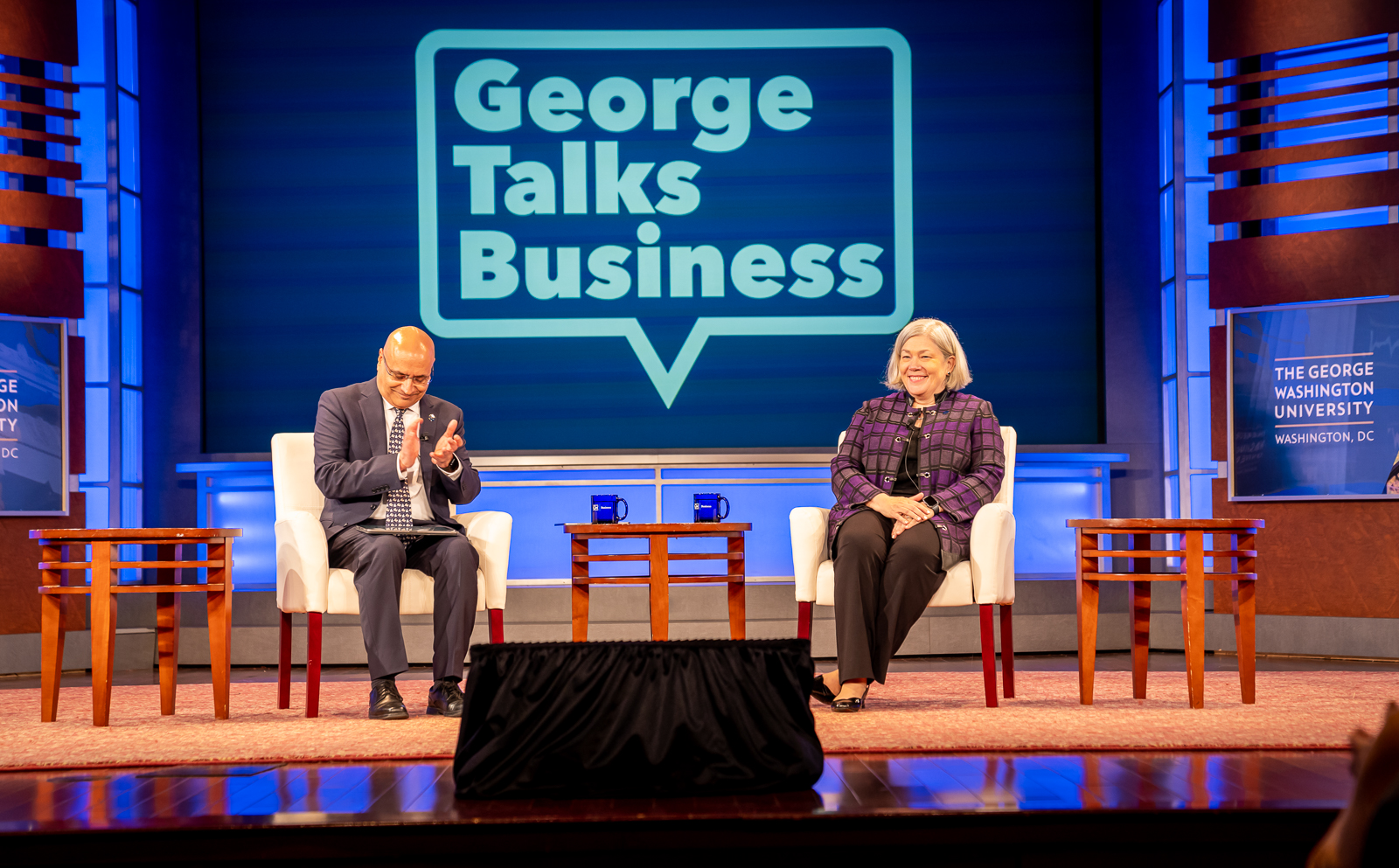In an event held to coincide with the inauguration of Ellen M. Granberg as the 19th president of the George Washington University, a panel of faculty experts convened to define excellence in academics and research.
Scholars at GW are currently addressing climate change, human rights, disease prevention, the effects of artificial intelligence and much more. Its deep legacy of impact is one of the reasons GW was invited to join the prestigious Association of American Universities (AAU)—a distinguished group of the nation’s most preeminent research universities—last June.
In addition to AAU membership, GW scholars have achieved noteworthy accomplishments worth celebrating, including an R1 Carnegie Classification designating a “very high research activity” university. And since 2019, GW has seen a 76% increase in total federal research and development expenditures.
In 2022 alone, GW faculty members authored and/or edited more than 100 new books. Many of these works of original scholarship were on display at the event, held Thursday in the Jack Morton Auditorium for invited guests and livestreamed for a virtual audience.
Panelists at the event were founding director of the Global Women’s Institute and Global Health Professor Mary Ellsberg; founding co-director of the Digital Humanities Institute, Professor of English, Women’s, Gender and Sexuality Studies, Theatre, International Affairs and East Asian Languages and Literatures Alexa Alice Joubin; Professor of Anthropology and National Chimpanzee Brain Resource Director Chet Sherwood; and Associate Professor and Department Chair of Engineering Management and Systems Engineering Ekundayo Shittu.
Granberg and Provost and Executive Vice President for Academic Affairs Christopher Alan Bracey each delivered welcoming remarks.
“For over 200 years, our faculty have delivered individual and collective excellence in hospitals, laboratories, neighborhoods, museum galleries, the halls of Congress and communities across the globe,” Bracey said.
Granberg noted that she “wanted an acknowledgment of our incredible faculty to be a cornerstone of this inauguration celebration.
“And that's why,” she said, “it’s such a pleasure to join you here today to recognize the GW faculty and their remarkable legacy of research, education, patient care and service. Our commitment to academic excellence was one of the primary things that drew me here, and I am truly honored to be a part of a community with such a remarkable history of impact throughout our world.”
Granberg expressed gratitude for the faculty’s excellent research as well as the support given to faculty by staff members, and recognized GW’s advantageous location in the nation’s capital.
“As the largest university in the heart of Washington, D.C., GW is a magnet for people who want to make a difference in their world and in their communities,” Granberg said. “GW continues to have an outsized impact on our country and our world.”
She celebrated GW’s joining the AAU: “Membership in the AAU is not just the gold standard in higher education,” she said. “It is the platinum standard. It signifies the highest levels of excellence among research universities and places GW publicly and formally among the best universities in North America.”
Despite the great achievements at GW to date, Granberg said she believes even greater things lie ahead.
“I really believe there’s much more potential across our campuses. There is much more need in the wider world, and our best days are still ahead,” Granberg said. “I want to work with all of you to be a catalyst for that potential. I want to remove barriers to collaboration, provide the resources and infrastructure needed for breakthroughs and advance the impact of scholarship at GW for years to come. I believe that together, we can raise higher.”
After the screening of a video celebrating research excellence at GW, Bracey introduced the faculty panelists and moderator, Pamela Norris, vice provost of research and Professor of Mechanical and Aerospace Engineering. Norris asked the panelists to briefly describe their research and then presented a series of questions, the first dealing with how proximity to the centers of power is leveraged.
Joubin celebrated the Folger Shakespeare Library and its award-winning theater as an “incredible resource,” noting that scholars from around the world come to the Folger as the “epicenter of not only Shakespeare studies but also premodern cultural studies.” Joubin said she has co-curated an exhibition and collaborated in various ways with Folger staff and brought her students there as well.
Sherwood celebrated the advantages that GW’s students derive from the Washington, D.C., location.
“We have graduates from the Human Paleobiology program who work in the Department of Energy, who are at the EPA, who are working at the White House and the Office of Science and Technology Policy,” Sherwood said. “That's the kind of thing that happens here that I wouldn’t imagine happening elsewhere. And it’s really wonderful to see.”
Ellsberg agreed that “we get a seat at the table by being so close,” noting that she has been able to “bring others to the table as well.”
Shittu spoke of the work he and his students have done in partnership with area organizations to address societal challenges, such as helping the area’s unhoused population.
“The misconception many people have is that homelessness is due to addiction or dereliction,” Shittu said. “But many of these people are actually people of strong acumen, mental stability and it’s just a transitional period for them.”
As part of a course on social innovation, engineering students visited Charlie’s Place, an organization that provides direct services to people experiencing homelessness in D.C. and hosted a member of its staff in the classroom to understand more about unmet needs and how GW students could help.
When Norris asked panelists about the role of risk in their research, Joubin noted that notions of risk and failure are historically and culturally specific. The idea that humans could fly was at one time a dream, and in another (think of NASA’s moon landing) a reachable goal.
Replying to a question about reaching across disciplines, Ellsberg said she has been able to tap the expertise of colleagues in other departments or schools from the beginning of her time at GW.
Norris actively encouraged such interdisciplinarity, saying, “I think a huge success for this symposium would be when the four of you submit a grant together.”
As a final question, Norris asked each panelist to describe what excellence and impact would look like at this moment.
Noting that her goal is to end violence against women, Ellsberg said she would like to partner with Sherwood to understand whether violence is innate.
“We hear so many people say you can't prevent violence, it’s part of our human nature, it’s part of our DNA, it’s caused by hormones,” Ellsberg said. “We have evidence now that shows that you can prevent violence.”
Noting that violence is featured in our very oldest stories, Joubin said, “Excellence in my field means a respect for and understanding of words, especially in the era of artificial intelligence.” People may think AI suggests a battle between humans and machines, Joubin added, but “it’s really humans versus humans” and humans with humans acting through their corporations and technology. “Words do matter,” Joubin concluded, because we can’t think clearly without appropriate words and metaphors.
For Sherwood, excellence means “doing work that matters, that improves people’s lives.”
Shittu concurred, saying, “For me, it’s putting smiles on people’s faces, saving that next life, ameliorating the challenge that an individual, or an organization, is facing.”
In closing remarks, Granberg thanked the panelists and said she had found their words energizing.
“I thought it would be wonderful to have faculty recognition as a signature part of the inauguration activities,” Granberg said. “I did not ever imagine that I would sit in a conversation where I laughed, I was deeply touched, I was deeply inspired, and I was so excited about the faculty here, the work they do and what the possibilities are for the future.”
The conversation may be viewed online.






